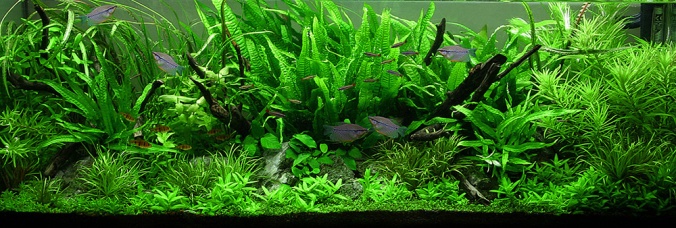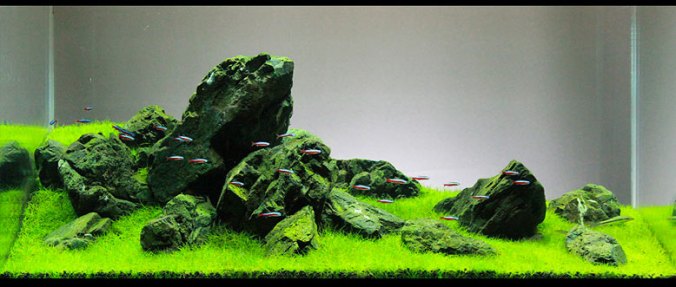This design is illustrious as an association of emersed and submersed setups. You may also know the German Open Style as a biotype or a type of paladarium.These layouts frequently start out with aquatic plants growing submerged and next allow them to grow emersed outside of an aquarium, can represent habitats including bogs, jungles, riverbanks, tropical rainforests, or even the beach.
The intentional objective is to create a part of nature that is more symptomatic of what you would find in a riverside environment, like at the edge of a waterway in the Amazon jungle. This type of style is more suitable for small and very small (nano-aquarium).
Author: soufiane
The jungle style
There is no formal definition of Jungle style, this style popularized by George Booth, favors plants and roots made with a much more wild, messier. Possibly the easiest aquascaping type to replicate, the Jungle style aquarium represents a great challenge for beginners people who have little knowledge.
The most fun thing about this style there are no rules, create what you like. You can select the plants you like, the aquascaping possibilities are only limited by your imagination, although the most used aquarium plants for this type of style are too tall, large-leaved plants. They can be bold and big, not like the Nature style, where you go for clean lines and fine texture.
This style of aquascaping incorporates the principles of natural aquascaping, but making the most savage and disorderly. Crazy jungle type aquariums are provided more hardscape and plants which are generally more impressive. They are generally concentrated around a central point and uses textures and colors around this point to draw the eye in selected directions.
The Iwagumi style
The Iwagumi style is based on a rock arrangement enhanced by a clean and turf vegetation, is one of the most challenging aquascaping styles out there, It is used to refer to an aquascape that traditionally uses stone as the only hardscape material. Developed around thirty-three years ago by Takashi Amano the most famous aquarist, this wild style of aquascape represents not just a minimalist layout, it also reflects the Japanese culture, spirituality and love for beauty and simplicity. a lot of you have heard the expression Iwagumi, exclusively if you frequent some of the more popular “forum” based websites combined with our aquascaping hobby. a lot truly do not differentiate what this translates to in English. The Iwagumi term itself comes from the Japanese “rock formation.” In a Japanese rock garden, rocks provide the ‘bony’ of the layout and mostly consist of three rocks; one major or large rock flanked by two smaller rocks, but not of equal size. When the rock arrangement is placed correctly, the rest of the layout will clearly fall into place. In our hobby, this has been taken far Behind three rocks but, the main principles should still be used.
The natural style
This is the Japanese landscape photographer Takashi Amano, who was the instigator of this style in the 1990s, inspired by Japanese gardens. this style is the one you’ve possibly seen all over the web, in diverse forums, and captivating tons of awards.
And for good reason they’re awe-inspiring tanks. These tanks seek to recreate different terrestrial landscapes hills, mountains, valleys, and so on. These are more categorized into different substyles, like the ‘island’ model, which features a stone ‘mountain’, or mound in the middle, or the triangular model, where the substrate and universal
flow the tank slopes down from one corner of the tank.
The Dutch aquarium, aquascaping history
Dutch (or Dutch) is a planted tank technique that looks like a well-maintained vegetable bed. Annual competitions have existed for almost 1960 to designate the most beautiful planted aquariums Dutch! For more information on the creation of Dutch aquarium certified to the requirements of this style, visit Adrian Tappin. In France, it is essentially Denis Terver that made this possible technique with its “Manuals Aquariology”, also known as aquascaping history, is a technique for large container planted popularized in the 1930s in the Netherlands, with the commercialization of the first aquariophilie equipment. This style emphasizes artificially structured and organized disposal of solid plant ordered in terraces, focusing on different forms, textures and colors like the terrestrial flower gardens.
The Japanese aquascaping, ADA and Amano

About aquascaping “Japanese”, the “master” of this technique is undoubtedly Takashi Amano. This technique is generally described as an aquascaping using nature as a template. That’s pretty vague, one must visit this thread on the results of ADA aquascaping contest to see some examples of his work and other sites to see how the aquariums are aquascapes. Amano describes three ways that you can use to aquascape aquarium in a Japanese philosophy of nature: triadic, concave and island. The hardscape then becomes crucial in creating the waterscape. The purpose of an aquascapeur “to” Amano is to take a picture representing its creation waterscape.
The aquascaping
Aquascaping, literally designating « creating waterscape », is an art of organisation nautical plants, as well as rocks, stones, cavework, or driftwood, in a harmonious attractive appearance within an aquarium in reaction, planting underwater.
The person practicing this art as an amateur or a professional is aquascapeur or aquasculpteur. He favors the aesthetics of the tank while the aquarium pays more attention to the fish and wildlife.
- styles:
There are different styles of aquascaping:
- Dutch style
- Japanese style
- natural Style
- Iwagumi Style
- jungle style
- German style
- biotope aquarium





